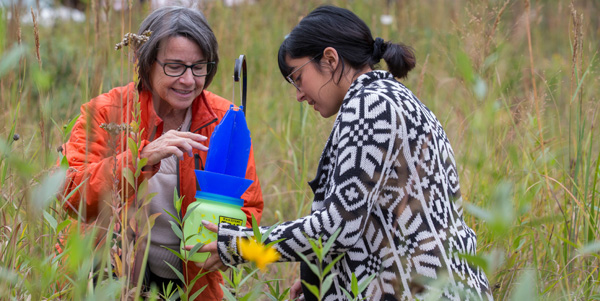
Small Prairies Offer Abundant Insights
When Benjamin Gue viewed the site for Iowa State University in 1858 it was mostly tallgrass prairie, as was about 80 percent of the state. The farmer and legislator who proposed the bill that established the State Agricultural College and Model Farm commented on the 648-acre location:
“… the great monotonous plain of waving grass only broken here and there by scattered groves … Standing on the eminence where the college now looms, we could only see one of the most beautiful landscapes in the west … ”
The grassland gave way to the campus, but there are still patches of prairie at Iowa State used for teaching, research and extension. There are about a dozen plots in Story and Boone counties ranging from 3 to 70 acres.
“In one way these patches are a good reminder of our heritage,” says Mark Honeyman, associate dean of operations for the College of Agriculture and Life Sciences, which includes its research and demonstration farms.
Although small in size, these plots are rich with opportunities to discover. Between Science Hall and Science Hall II is a third-of-an-acre prairie plot. Mary Harris, an adjunct assistant professor in natural resource ecology and management, uses the prairie for the pollination biology course she teaches.
“I take the class there three times early in fall semester to get hands-on experience estimating plant diversity and observing how different pollinators interact with the variety of blooming prairie plants. Students love this experience and it is great to have this outdoor classroom just outside the building; it means we can meet and conduct class within the allotted 50 minutes,” she says.
The newest patch is a 10-acre prairie at the Horticulture Research Station near Gilbert. It was planted in 2015.
“Pollinators benefit from a diverse, perennial plant environment, like prairie. That was a driver for establishing prairie at the Hort Station because every apple, every squash, every tomato has to be pollinated,” Honeyman says.
That prairie also was part of the Monarch butterfly habitat project and surrounds a 300-year-old burr oak, which is the 14th largest in the state of Iowa. Prairie plots also are labor-savers.
“If it’s a well-established prairie, we don’t have to mow it or control weeds, and we only need to burn it every few years,” Honeyman says.
In addition to the restored prairies, there is a 3-acre patch of native prairie (original to pre-tillage times) at the university dairy farm. Two acres of restored prairie were added and it was named for Marvin Anderson, a former dean of extension, who did graduate work there, and Robert Dyas, a landscape architecture professor who was an expert on prairie.
These small research venues offer great insight. Proximity and access benefit students and faculty alike.



